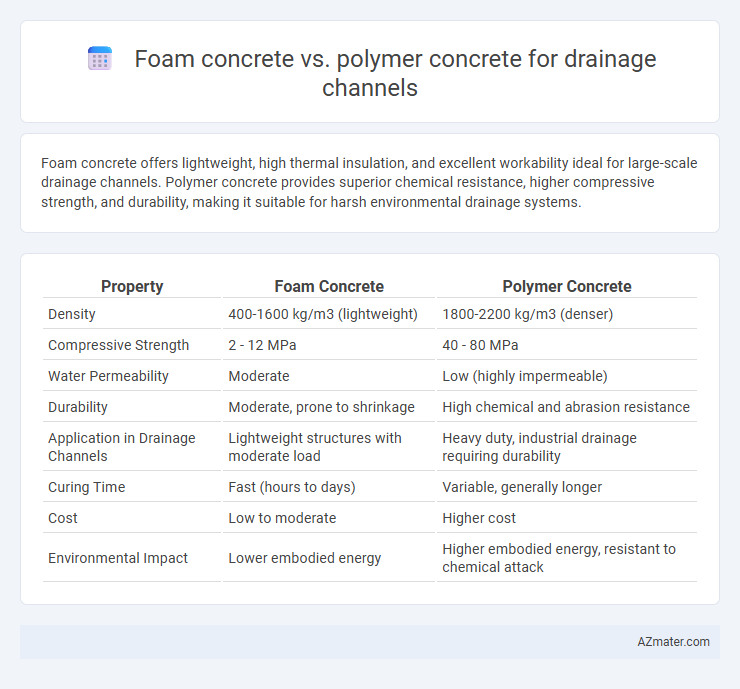Foam concrete offers lightweight, high thermal insulation, and excellent workability ideal for large-scale drainage channels. Polymer concrete provides superior chemical resistance, higher compressive strength, and durability, making it suitable for harsh environmental drainage systems.
Table of Comparison
| Property | Foam Concrete | Polymer Concrete |
|---|---|---|
| Density | 400-1600 kg/m3 (lightweight) | 1800-2200 kg/m3 (denser) |
| Compressive Strength | 2 - 12 MPa | 40 - 80 MPa |
| Water Permeability | Moderate | Low (highly impermeable) |
| Durability | Moderate, prone to shrinkage | High chemical and abrasion resistance |
| Application in Drainage Channels | Lightweight structures with moderate load | Heavy duty, industrial drainage requiring durability |
| Curing Time | Fast (hours to days) | Variable, generally longer |
| Cost | Low to moderate | Higher cost |
| Environmental Impact | Lower embodied energy | Higher embodied energy, resistant to chemical attack |
Introduction to Foam Concrete and Polymer Concrete
Foam concrete is a lightweight, aerated material composed of cement, fine aggregates, water, and a stable foam mixture, offering excellent thermal insulation and low density ideal for drainage channel construction. Polymer concrete incorporates resins such as epoxy or polyester, enhancing mechanical strength, chemical resistance, and durability, making it suitable for high-load and corrosive environments in drainage applications. Both materials provide distinct advantages: foam concrete excels in weight reduction and thermal properties, while polymer concrete delivers superior performance in structural integrity and longevity.
Key Material Properties Comparison
Foam concrete offers lightweight properties with high thermal insulation and fire resistance, making it suitable for drainage channels requiring reduced structural load. Polymer concrete provides superior chemical resistance, high compressive strength, and enhanced durability against abrasion and freeze-thaw cycles, ideal for harsh environmental conditions in drainage applications. The choice between foam and polymer concrete depends on balancing weight considerations versus durability and chemical exposure in drainage channel design.
Strength and Durability Differences
Foam concrete offers lightweight properties with moderate compressive strength typically ranging from 3 to 15 MPa, making it suitable for non-structural drainage channels with good thermal insulation and reduced load on foundations. Polymer concrete provides significantly higher mechanical strength, often exceeding 70 MPa, alongside superior chemical resistance and durability against aggressive environments, ensuring longevity in harsh drainage applications. The enhanced bond strength and impermeability of polymer concrete result in minimal water absorption and increased resistance to freeze-thaw cycles compared to foam concrete.
Permeability and Water Resistance
Foam concrete exhibits higher permeability compared to polymer concrete, allowing for better water drainage in channel applications. Polymer concrete offers superior water resistance due to its dense, non-porous matrix, making it ideal for environments with prolonged water exposure. Selecting polymer concrete enhances durability and minimizes water infiltration, while foam concrete is preferable for channels requiring efficient water flow and drainage.
Installation and Workability Factors
Foam concrete offers superior workability due to its lightweight, flowable consistency, allowing easy placement and filling of complex drainage channel shapes with minimal compaction. Polymer concrete provides rapid curing and exceptional chemical resistance, but requires precise mixing and skilled labor to ensure proper bonding and avoid installation defects. Foam concrete's ease of handling and lower equipment needs make it suitable for large-scale projects, whereas polymer concrete excels in durability and resistance in harsh environmental conditions.
Cost Analysis and Lifecycle Economics
Foam concrete offers lower initial material and installation costs compared to polymer concrete for drainage channels, making it a cost-effective choice for large-scale projects. Polymer concrete, while more expensive upfront due to higher material and specialized labor costs, delivers superior durability and chemical resistance that can reduce maintenance expenses and extend service life significantly. Evaluating lifecycle economics, polymer concrete often results in lower total cost of ownership over 25-30 years despite its higher capital investment, thanks to its resistance to corrosion, abrasion, and environmental stressors.
Environmental Impact and Sustainability
Foam concrete offers enhanced sustainability due to its lower cement content, reduced raw material usage, and superior thermal insulation properties, which collectively minimize carbon emissions during production and improve energy efficiency in drainage systems. Polymer concrete provides exceptional durability and chemical resistance, extending the lifespan of drainage channels and reducing maintenance frequency, but its reliance on synthetic resins and non-renewable petrochemicals raises environmental concerns. Selecting foam concrete can lead to a more eco-friendly drainage solution by leveraging lightweight, recyclable materials with a smaller carbon footprint compared to polymer concrete's resource-intensive composition.
Maintenance and Longevity Considerations
Foam concrete offers excellent lightweight properties and ease of installation for drainage channels but may require more frequent maintenance due to its porous structure, which can lead to surface wear and potential water infiltration over time. Polymer concrete, known for its superior chemical resistance and tensile strength, provides enhanced durability and longevity, reducing the frequency and cost of maintenance in harsh environments. Choosing polymer concrete ensures long-term performance in drainage applications with minimal degradation, whereas foam concrete may be better suited for projects prioritizing cost-effectiveness and ease of handling.
Performance in Different Drainage Scenarios
Foam concrete offers excellent thermal insulation and lightweight properties, making it suitable for drainage channels in areas with fluctuating ground temperatures and requiring easy installation. Polymer concrete provides superior chemical resistance and mechanical strength, ideal for highly corrosive environments or heavy traffic drainage systems. Selecting between foam and polymer concrete depends on factors such as load-bearing requirements, exposure to aggressive chemicals, and installation constraints in varying drainage scenarios.
Conclusion: Choosing the Ideal Concrete for Drainage Channels
Foam concrete offers excellent thermal insulation, lightweight properties, and ease of installation, making it suitable for non-structural drainage channels where weight reduction is critical. Polymer concrete provides superior chemical resistance, high compressive strength, and durability, ideal for heavy-duty drainage channels exposed to aggressive environments. Selecting the ideal concrete depends on project-specific requirements such as load capacity, exposure conditions, and cost considerations.

Infographic: Foam concrete vs Polymer concrete for Drainage channel
 azmater.com
azmater.com